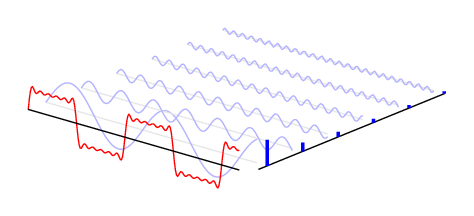A time-frequency correspondence illustration of the Fourier transform.
This code was written by Jake on TeX.SE.
Edit and compile if you like:\documentclass[border=10pt]{standalone}
\usepackage{pgfplots}
\pgfplotsset{width=7cm,compat=1.6}
\begin{document}
\begin{tikzpicture}
\begin{axis}[
set layers=standard,
domain=0:10,
samples y=1,
view={40}{20},
hide axis,
unit vector ratio*=1 2 1,
xtick=\empty, ytick=\empty, ztick=\empty,
clip=false
]
\def\sumcurve{0}
\pgfplotsinvokeforeach{0.5,1.5,...,5.5}{
\draw [on layer=background, gray!20] (axis cs:0,#1,0) -- (axis cs:10,#1,0);
\addplot3 [on layer=main, blue!30, smooth, samples=101]
(x,#1,{sin(#1*x*(157))/(#1*2)});
\addplot3 [on layer=axis foreground, very thick, blue,ycomb, samples=2]
(10.5,#1,{1/(#1*2)});
\xdef\sumcurve{\sumcurve + sin(#1*x*(157))/(#1*2)}
}
\addplot3 [red, samples=200] (x,0,{\sumcurve});
\draw [on layer=axis foreground] (axis cs:0,0,0) -- (axis cs:10,0,0);
\draw (axis cs:10.5,0.25,0) -- (axis cs:10.5,5.5,0);
\end{axis}
\end{tikzpicture}
\end{document}
